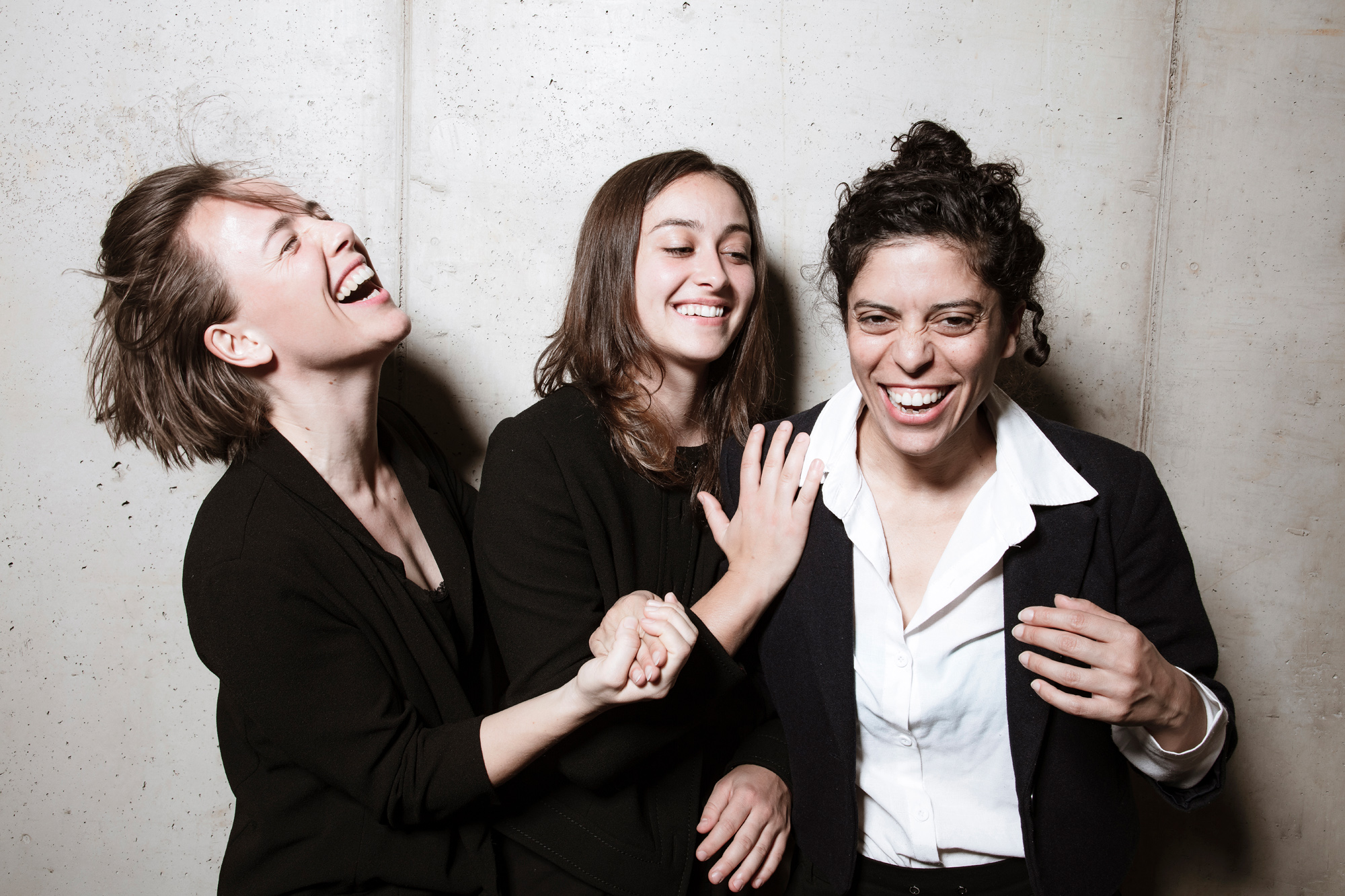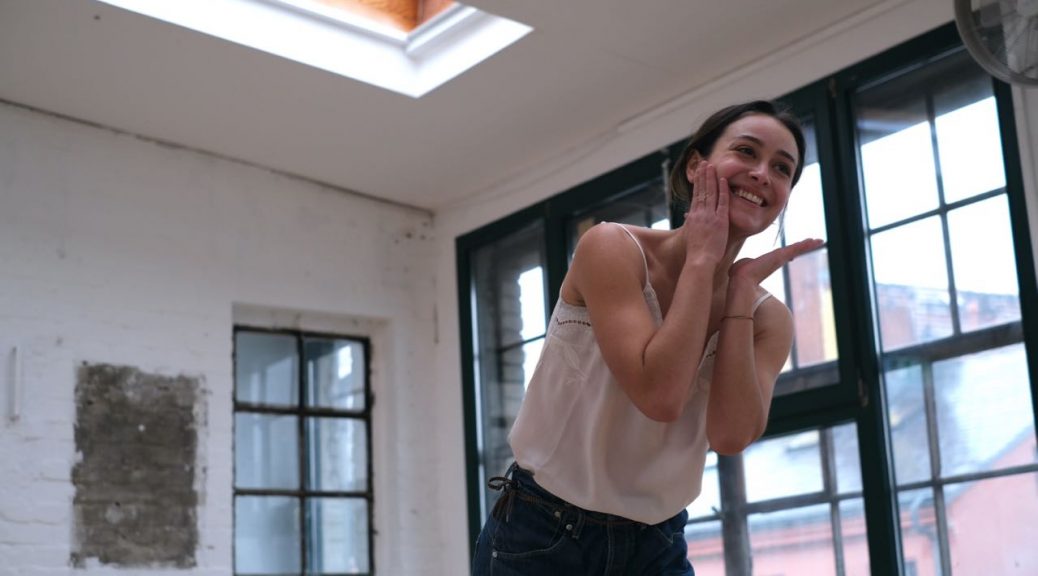
Naïma Mazic
Naïma Mazic (Vienna/Berlin) founded the association more2rhythm and the international company n ï m in 2016 with its first project and performance in Cuba, Havana. 2024 she is artistic director of LAKE Studios Berlin.
In 2018/19 Naïma was choreographer in residence at K3 Tanzplan Hamburg/Kampnagel and finished her MA in Performance Studies from New York University TISCH School of the Arts 2020. She furthermore studied dance at P.A.R.T.S., the Reykjavik Academy of Arts, AHK Amsterdam and at the Vienna Academy of Music and Performing Arts/MUK. Naïma Mazic has been invited to the HipHop Continuum of Jacob’s Pillow Dance Festival USA, Urban Dance Project in Kolkata, India and ImPulsTanz DanceWeb15 & 22. She has been working with choreographers/ directors such as Alix Eynaudi, Doris Uhlich, Talia DeVries, Volker Schmidt (Wiener Festwochen), Erna Ómarsdottir/ Shalala Company, Athina Tsangari (Salzburger Festspiele) and musicians such as Alain Franco, Robyn Schulkowsky, Leon Parker, Maria Kim Grand, Elias Stemeseder,… In her work, Naïma focuses on the musical independence of dancers and concentrates on the communication between dancers of different backgrounds and (jazz) musicians through polyrhythms. Her work is based on tools of jazz music, replenished by sensuality. Currently Naïma is conducting research on the femininity of jazz music. She has been an evening manager at the Jazz- & Music Club Porgy & Bess since 2011 and is European Jazz Network Representative. She developed the workshop OF(F) Rhythm. With n ï m company she performed her work, among others, at brut Vienna, el cierbo encantado, at CAB Brussels, the Vienna Art Week / Kunstraum NÖ, Judson Church NYC, Leipziger Jazztage, brut Wien, loft Cologne, DOCK11 Berlin and more. Furthermore, Naïma is directing music videos for musicians and working as a commissioned choreographer for dance & music Ensembles such as uBu. Naïma is starting to establish regular Jam Sessions for jazzmusicians and dancers in Berlin, Vienna and further cities.
“THERE’S SOMETHING IN THE RHYTHM YOU CAN’T WRITE DOWN” – NAÏMA MAZIC, PART I

* This interview was previously published on Asutrian Music Export.
To experience a production by the n ï m company is to watch artists step out of their comfort zones: jazz musicians dance; dancers create and perform music. It’s a melting of disciplines, a dissolving of boundaries, and the audience is cut loose from its normal points of orientation, in the very best sense. Naïma Mazic, the mastermind behind n ï m, grew up steeped in jazz and trained as a dancer; in the first part of this two-part interview, she speaks to Arianna Alfreds about the heartbeat of jazz, bridging the gap between music and dance, and getting jazz musicians to show up at 9 a.m.
What part of the world are you currently beaming from?
Naïma Mazic: (laughs) Right now I’m in Berlin. I’m generally between Berlin and Vienna, working and living in both places at the moment.
You’ve been on a residency?
Naïma Mazic: Yes, at LAKE Studios Berlin. It’s been a great opportunity to dive deep into research and work. I’ll be the artistic director there for one year starting from November.
But your roots are in Vienna. Can you talk about your unique upbringing and how it’s tied you to music?
Naïma Mazic: I grew up in the Vienna jazz club Porgy & Bess. My mother, father, and stepfather [Gabriele Mazic, Mathias Rüegg, and Christoph Huber] and Renald Deppe founded it together, and my dad is also a composer and musician. So even aside from the club, there was always music being played around me. And growing up and touring with a jazz big band [the Vienna Art Orchestra], just being surrounded by music – it made an impact, of course.
I also worked at Porgy for many years and was always deeply connected to music, also through piano playing and singing in choirs. But at a certain point, dance took over. It was clear for me that dance and music feed each other, and that my own musicality had to be pushed through dance. Especially when I started to get into the hip-hop scene, dancing house, breaking, and swing dance, where I often noticed another approach to musicality within the body as compared to contemporary dance.
“THE MORE I LISTEN TO MY BODY, THE MORE I’M ABLE TO LISTEN WITH MY BODY.”
So your initial interest came from personal practice, not out of a formal education.
Naïma Mazic: Yeah. It’s always been interesting to me to see how contemporary dance, music and rhythm are taught in schools. I always felt there is a lack of education on how to really listen to music and rhythmic knowledge that can really work with music, not just use music. Like, how to truly bring them together. I think in Western society, there’s often a lack of connection to the body. So I felt there was something lacking for the dancers regarding musicality; but also for the musicians – how to deal with the body and dance. For example, many musicians I work with say that as soon as they work with music and rhythm with their body, their playing changes. I also noticed for myself over the last year that the more I listen tomy body, the more I’m able to listen with my body to music.
So, even though you were more or less born into it, you had to find your own approach to (jazz) music.
Naïma Mazic: Definitely. For me, that was living in New York and meeting Haggai Cohen-Milo, a bass player who works with dancers a lot. He played at Porgy once and we started talking, and that’s how the collaboration began, for instance on the piece “infectious”. Before that, I had worked with musicians and composers, but with Haggai it felt for the first time I was actuallyworking in [a way that was]…(pauses)…transdisciplinary? Interdisciplinary? I feel like we make disciplines in the first place, so to then call it ‘interdisciplinary’ or whatever is somehow…
Arbitrary?
Naïma Mazic: Yes, I wonder about this a lot. Anyway, I started to ask Haggai: “How do you practice rhythm, or a scale? What do you do?” And then I took tools that he would use and put them into dance and choreography, and I felt like, “wow, I can work in rhythm like you do.”And then we can start speaking a common language.
And that was when you started to connect the two disciplines – jazz music and dance?
Naïma Mazic: Yes, I would say so. In 2015 I started studying at P.A.R.T.S. in Brussels, with Anne Teresa de Keersmaeker. She is known for bringing rhythm and musicality into her work. I was doing a so-called ‘post-master’s’ there, where I had to develop my own project. I started asking fundamental questions, like, “how can the heartbeat of jazz function in dance? How can dance and jazz communicate and get into dialogue?”
“THERE’S SOMETHING IN THE RHYTHM THAT YOU CAN’T WRITE DOWN.”
Besides the fact that you grew up with it, what is it about the genre of jazz, specifically, that continues to inform and inspire you?
Naïma Mazic: (long pause) There’s something about freedom within form, expressing your voice or story through music. I mean, what’s also interesting is the question: What is even jazz? The term is already a problem. But something I think I learned from dancing house, hip-hop and breaking is that there are these given elements – let’s say melodic and harmonic, or certain basic steps. But then the vital component of jazz, improvisation, is taking these elements and telling your own story with them. It’s all about what you make of the language, how you improvise with it. I think that’s very beautiful: we all have the same base, but we talk in our own ways, our own dialects, with our own narratives. And I think that really connects to the porousness or sponginess of jazz in general: that so many rhythms or movements from different places and cultures come together in it. There’s something in the rhythm that you can’t write down. Something that grooves, swings.
Fred Moten, my teacher at the NYU Tisch School of the Arts, said: “Jazz is, at the same time, the music of freedom and a critique of freedom.” And I think this is very fitting, because if you think of oppressed [peoples] and colonization, then in order to be free, you need something that is not free, something to free yourself from. That perspective was always very inspiring to me. And there is a very spiritual aspect to it that I found very beautiful and important.
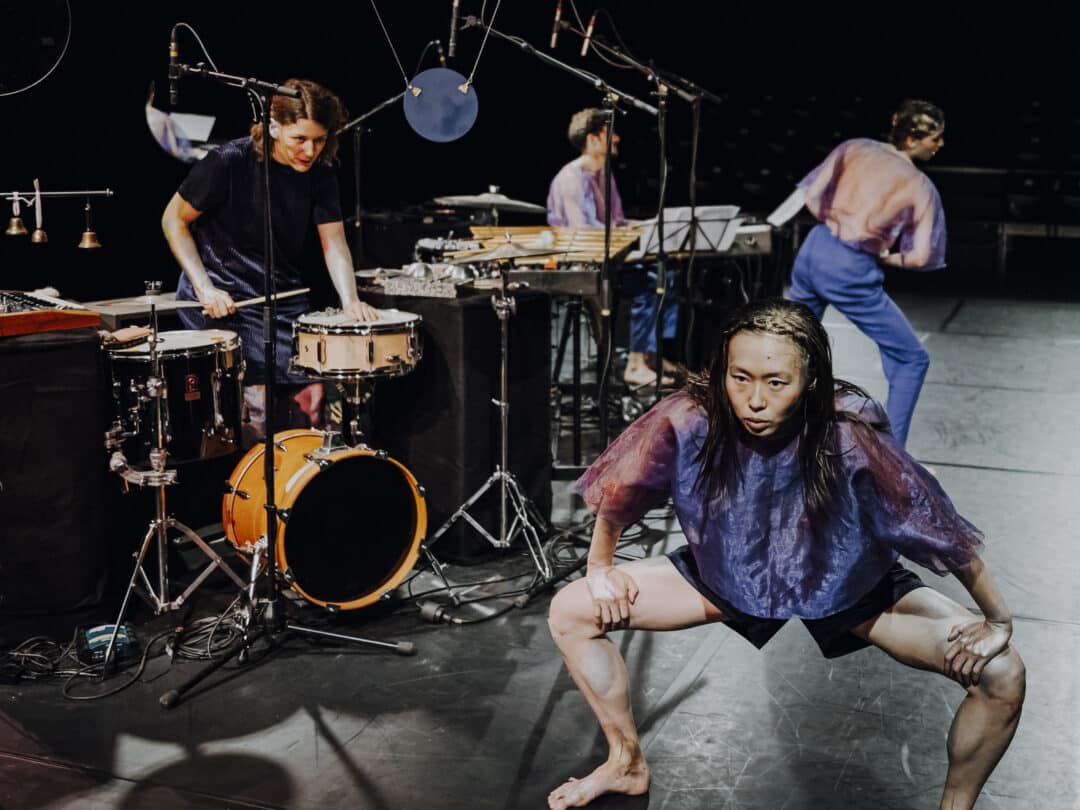
You go to a lot of shows. How does this affect your practice?
Naïma Mazic: I learn a lot from watching jazz concerts – that’s where I get my inspiration for choreography. I don’t go anywhere without my notebook. And the more I enjoy the music, the more I fly and scribble away. I look at how the musicians communicate: “Okay, now they’re hanging out casually around the bass, watching the other person’s solo, or talking between songs about what they ate today.” As compared to a classical dance performance, where I feel a certain strictness or theatricality, where there is not the same interaction or communication for me. That’s something I love about jazz – being allowed to be yourself.
Would you consider yourself a bridge between jazz and dance? Or is it more integrative than that? (A bridge implies a connection between two things, rather than one unified entity.)
Naïma Mazic: Hm, a bridge – that’s interesting. I think about Black culture and African aesthetics in America, and when I think of the swing era, the music is what it is because of the dancers: the musicians watching the dancers and vice versa. The dance and the music evolved by being unified. So, yes, I think there is a certain bridge that needs to be made – especially here in Europe and in contemporary dance, where I feel like jazz music and dance are mostly very separate.
What moves me is this working together by feeding [into one another], exploring together and developing a communication together. And not just being in dialogue but creating a [shared way of] thinking. Like, what kind of thinking do we need to get to certain places that are so connected, and yet still maintain our individual voices?
“I CAN FEEL A SHIFT IN CURIOSITY TO OPEN UP MORE TO OTHER ART FORMS.”
Has it been a challenge to find people to collaborate with that are like-minded, to convince people to be open to experience both sides – jazz and dance?
Naïma Mazic: Actually, no. I’ve been extremely lucky, but I think many musicians and dancers are open to this. I can feel a shift in curiosity to open up more to other art forms, and especially to dance. People actually contact me – I get messages from musicians saying, “hey, I heard about what you’re doing. I would love to improvise with dance.” I feel like there is a lot of interest, people realizing the importance of it, and also musicians wanting to move themselves.
Many jazz musicians have worked together with dancers, but more in the States. And also, jazz is still a male-dominated field; I think that plays a role. At the same time, I think as a jazz musician you have to be open to be part of the ‘sponginess’ that I was talking about before. But I still think there’s sometimes…and I don’t know how to put it in words…
…Something more conventional going on, getting in the way?
Naïma Mazic: Yeah, like about practicing…there’s something about ‘virtuosity’ and the concentration of practicing that doesn’t give so much space for interdisciplinary work. But also working in this way is not easy, because to speak the same language in an artistic sense, or find ways of working together artistically is one thing, but there’s so much around it.
Like practical issues?
Naïma Mazic: Yes – for example, dancers are just used to running around naked. And then you have like five male jazz musicians – how do they react in a dressing room with five naked women [or female-identified bodies]? Or the payment might be super different between disciplines. So, for me, as a contemporary dancer, with our very low salary – it’s often hard if I want to work with good musicians. I don’t know where to get the money, because that’s just not how we are paid in dance. Often, jazz musicians of a certain level are used to better payment, a nice hotel and good food, et cetera.
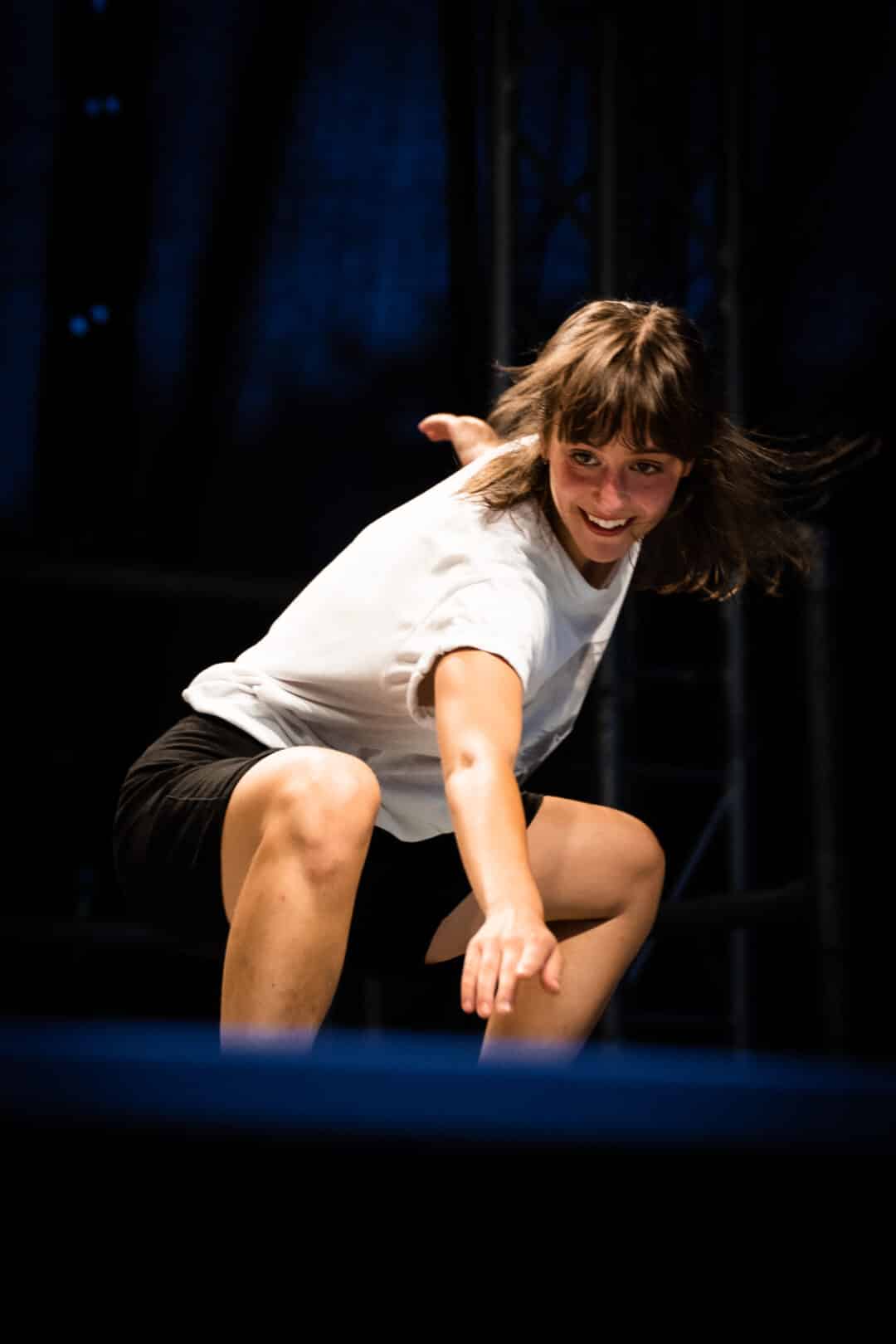
Okay, that’s a big challenge.
Naïma Mazic: Yes, for example, we were at the Leipziger Jazztage and my production assistant was like, “okay, everybody has to be at the theater at 9:00 in the morning.”And I was like: “But there’s going to be setup for stage design and light. Nobody’s going to work until the afternoon.” And he was, like: “It doesn’t matter. We’re in the theater. Everybody knows you have to be in the theater at 9:00 and just be available.” We dancers are very used to just hanging out and waiting. But to bring a jazz musician to the theater at 9 a.m., to just hang out and do nothing?
Haha, good luck.
Naïma Mazic: Exactly. So, yeah, I know I have the responsibility – not only in the artistic sense, but in all the structural things: how do these two worlds actually work together? Dancers rehearse six or eight weeks, eight hours a day. Warm-up, et cetera. Musicians? I get two comments. One is: “Sorry, but I can’t; that’s too much for me.” And the other is: “I wish we would rehearse this much with my band! The music would be so good!” (laughs)
In terms of building a bridge, it sounds like the “HEAR & NOW” jam sessions that you’ve recently started are a very useful, low-commitment way for musicians and dancers to get a taste of what it’s like to work together. Can you tell us about the sessions and how you came up with them?
Naïma Mazic: I’ve been researching the histories of music and dance, including the loft scene in New York [in the 70s and 80s]. Ornette Coleman had a loft where dancers would just show up, and there were lots of examples where jazz and dance came together at that time [see for instance Dancing in Blackness, a memoir by Halifu Osumare]. This really inspired me – the idea of having a space to meet and jam together, but within a framework. So at the sessions, I give an introduction and suggest tools and methods from time to time, and then it kind of runs by itself. The first one happened at the end of February at LAKE Studios in Berlin, and it was beautiful. What was so important for me, and really worked, was that there were house dancers, lindy-hop dancers, contemporary dancers and dance lovers. And again, the work of rhythm brings things and people together really strongly. In this jam session, we had Keisuke Matsuno on guitar and other musicians as well, and people left very happy, saying, “I feel so good in my body!” So, I want to do it every month if possible.
You also plan on doing it in Vienna, right?
Naïma Mazic: Yes, the next one will take place on May 7th from 6-9 p.m. in the Strenge Kammer at Porgy & Bess [to participate, email more2rhythm@gmail.com]. And after that, on the 2nd of July at the LAKE Studios 10th Anniversary Festival in Berlin.
Arianna Alfreds
Read part II of the interview here!
“AN ENERGY I HAVEN’T FELT BEFORE” – NAÏMA MAZIC, PART II

* This interview was previously published on Asutrian Music Export.
To experience a production by the n ï m company is to watch artists step out of their comfort zones: jazz musicians dance; dancers create and perform music. It’s a melting of disciplines, a dissolving of boundaries, and the audience is cut loose from its normal points of orientation in the very best sense. Naïma Mazic, the mastermind behind n ï m, grew up steeped in jazz and trained as a dancer; in the second part of this two-part interview, she talks about her research into the women behind famous jazz standards, getting into directing videos, and getting booed at a jazz festival.(Looking for part I? You can read it here.)
You’re currently conducting research on femininity in jazz music. How did you come to this?
Naïma Mazic: Growing up in Vienna in a jazz club and in the hip-hop scene, I felt like: where are the women? I just didn’t have role models. It was clear that I could/should play piano and sing, but that’s it. You know, my father always said, “If you had [been drawn] to another instrument, it would have come.” But I have to say that role models are extremely important! If I had seen more female musicians playing other instruments, I think that would have changed a lot for me.
I remember the first concert – 2017 or 18, I think – when I saw a female jazz trio on stage at Porgy. I’m not saying it was the first one of only women, but for me it was. I saw Savannah Harris, Linda Oh and Maria Kim Grand on stage, three of the absolute top jazz musicians for me. And I just cried because I couldn’t believe what I was seeing: an energy I haven’t felt before, a different sound, an unfamiliar way of being with the audience. It really blew my mind.
“THERE ARE ENDLESS STORIES, AND I WONDER HOW MUCH MORE WE DON’T KNOW.”
What has your research turned up so far? What are you doing with your findings?
Naïma Mazic: I wanted to see how I could turn jazz standards into a choreographic score, how I can be in conversation with a song, even on a recording, and become like another instrument – not just dance to the music. Then I realized that all of the tunes I was working with are named after women. I was working with John Coltrane’s “Naima”, Sam Rivers’ “Beatrice”, “Lonely Woman” from Ornette Coleman…and I wondered, wait, who are all these women?
So I started to collect jazz tunes named after women, and in the process I discovered incredible musicians, artists, women. It’s mind-blowing how much material there is, and that’s the basis of my current work, “ALBUM” – the figure of the muse in jazz.
There are the ‘classic’ stories about the women who supported male musicians – managers or artists who gave up their own art, the whole ‘there’s a woman behind every man’ story. There are the female artists who never got as recognized as their male partners, obviously. And the stories of women who gave up their own lives to support their men, especially in the 70’s, when there was a lot of drug abuse, and women became like nurses or hospice workers for their husbands, doing everything behind the scenes.
There are endless stories, and I wonder how much more we don’t know. How many books have been published under a man’s name; how many men have taken credit for a woman’s work? I’m curious about the hidden femininity in jazz. I think there is a lot a lot to discover – like now that Terri Lyne Carrington published the book 101 Compositions by Female Composers: there is so much music that is already there; it’s just often under the rug.
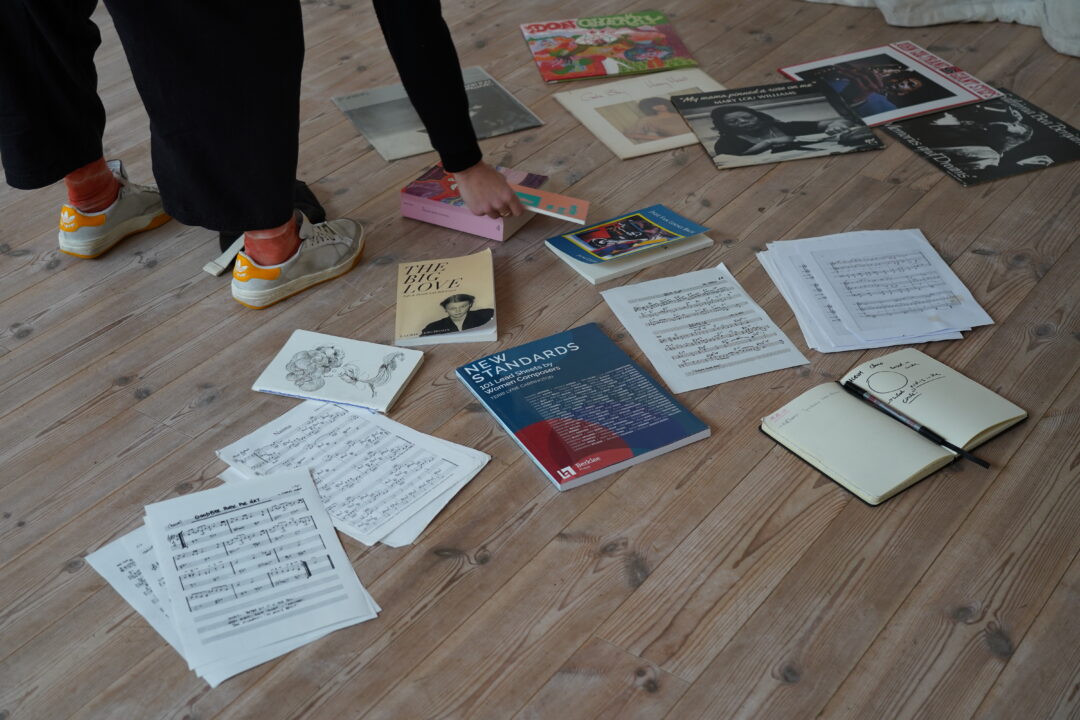
And how is this reflected in your choreography and performance work?
Naïma Mazic: I’ve been working with Golnar Shahyar and with Evi Filippou here in Berlin, and I am in exchange with Maria Kim Grand. At the moment there are three categories I’m looking into: first, songs named after women who have supported [male] musicians or carried on their legacy, like Nellie Monk, Sue Mingus and many more. Second, songs in collaboration with women who were artists themselves, like Moki Cherry, who had the Organic Music Society with Don Cherry, or Alice and John Coltrane, or Lil Hardin Armstrong. Third, songs written by women that stand on their own: Carla Bley, Toshiko Akiyoshi, Mary Lou Williams, Jutta Hipp, the list goes on…
With this project, it’s important to be in service of the women’s voices, but also to think about what I want to tell and leave room for: it’s a performance, not an academic paper. So what we’ve been working on choreographically is taking the stories of the women but also drawing from the music itself, as well as from the figure of the Muse in Greek mythology.
You’ve also recently started directing music videos. Who have you been working with? What have you experienced so far?
Naïma Mazic: I’ve made two music videos: one for Lia Pale and one for TOYTOY, a band from Hamburg. The next one will be for Golnar Shahyar. I think musicians ask me because they know of my in-depth work between music and dance. And in general, I think there is a big interest right now in movement and dance – how music can be embodied, or shown visually through the body. It’s been interesting to work with film, where, for example, there’s the possibility of the close-up, which you don’t have in theater or performance. I can choose that at a certain moment, the rhythm will only be shown by the eyes, or by the hand. I’m fascinated by fragmentation, choosing where to put the gaze, which is interesting, because in music, too, when you do a recording with multiple instruments, you can choose to put the focus on one of them.
I love to work with pre-composed music and think of imagery. I love making a world out of a song through film, finding the connection between dance and music in a way that functions in film. I like blurring the boundaries between short film, art film, dance film and music video. I’ve started working closely with filmmaker and artist Alaa Alkurdi; we will release something we’ve been working on soon.
Over the past 10 years you’ve developed, as you put it, “a method of learning and embodying time and pulse: independent rhythmic skills and polyrhythms to be used as communication tools with musical partners”. What does this look and feel like in practice?
Naïma Mazic: Milford Graves said, “we are not interested in being metronomic.” You can’t cross a highway in a marching step! (laughs) But I practice with my dancers using a metronome. I think there is something about being able to keep time; the body remembers each tempo astonishingly well. So for dancers to actually be independent rhythmically, they have to have certain tools first. There is a basic necessity to keep time, to feel the pulse underneath rhythms; what connects us in the end is the pulse. And for dancers and musicians to feel that and keep time together takes a lot of practice.
But going further, I’m interested in what happens if we dance in, for example, [5/4 time]. Like, there’s the comfortable, known 1-2-3-4… but then there’s this other beat on top. What do we do with it? I’m always so fascinated by what a different meter and tempo do to the body, and to improvisation in dance, because you have to leave your automatism. It takes a lot of practice rhythmically, and then to move on to beats and offbeats, different subdivisions, polyrhythms within the body…I always struggle with, or I’m encountering, the intuitive part – dancing a rhythm by feeling it in your body – as opposed to the analytical approach, counting and being more in your head and less in your body. So the learning phase is super restrictive, but once you deepen your practice, you find the freedom in it.
“IF THERE ARE MANY FEMALE MUSICIANS AND DANCERS ON STAGE, WHO SHOWS UP?”
Can you tell us about your project “PoLy-Mirrors”?
Naïma Mazic: It was the first piece I’ve ever shown at a jazz festival – the Leipziger Jazztage at the Schauspielhaus Leipzig with Georg Vogel and Evi Filippou. We also gave a workshop with a performance the same day for jazz students at the university there and dancers from Leipzig. I’m also mentioning it because the benefit was so palpable. The musicians afterwards were, like, “now I really want to work with dancers.” So I think it’s really something to think about regarding education; it’s time to start implementing this. And I was so happy and inspired by the situation; we were really surprised that the younger generation was so into it.
What was also interesting was that I got my first “boo” there after the PoLy-Mirrors show.
Really? And you found it interesting, not offensive?
Naïma Mazic: Yeah (laughs). I had to think of my dad showing me “Boo to You Too” by Carla Bley. Afterwards I was told that it was one of these “jazz police” types – you know, there are a lot of these older white European men at jazz festivals. So I’m also really interested in the fact that this work I’m doing brings new audience members. Who comes to see jazz and dance – and if there are many female musicians and dancers on stage, who shows up?
So I actually took it as a compliment: if we get booed at a jazz festival, where I know it’s not related to the quality but that it does something to somebody that strongly, then it’s very interesting. It shows something about this scene – how open musicians are to working with dancers is one thing, but how open is the audience? How open are the clubs? How open is the world?
In “PoLy-Mirrors”, I’m interested in how diagonals in and through the body perform something that is perceived as feminine – the gaze, the eyes, the tilting of the head, the twisting of the body, [like with] Virgin Mary figures. Also in European Baroque and Renaissance paintings, it has clearly been made into something feminine. It was very interesting to use this choreographic conceptual tool while working with a composer, finding out that the diagonals are maybe creating something we perceive as submissive – but also something powerful: in the body, you need diagonals to create groove. The composer, Elias Stemeseder, and I approached this from many angles. It was a beautiful way of working – closely together, but also independently.
It’s a great example of how organically these two fields can work together when you are open to it.
Naïma Mazic: Yes – and I have to say, one piece that Elias wrote using choreographic tools [and] that we talked about is played a lot now. I’ll come to a club in Berlin and hear it; Evi has it on her new album as well. I’m very thankful that she put it in her album notes that it was created for “PoLy-Mirrors”, with the n ï m company. I think we have a responsibility to credit each other. If word would be spread more that a piece has been done in collaboration with a choreographer and dancers, maybe more curiosity would arise for other people to work with dance. It shows that the work keeps going on.
You’re bringing (at least) two disciplines together. Could you imagine a term for this? Like, let’s say you were to offer a class at a university, or even an entire curriculum?
Naïma Mazic: Hm…maybe ‘the musical body’.But I need to think about it.
What have you got coming up?
Naïma Mazic: A few things, actually. An initial, shortened version of “ALBUM” will be presented at the LAKE Studios 10th Anniversary Festival in Berlin on the 23rd of June, and the actual premiere is from the 12th-15th of October at Brut (Vienna).
I’m also performing on the 16th of June with musician Maria Coma at the SOUNDANCE Festivalin Berlin at DOCK11. And I just got invited to show my work at the Bozcaada Jazz Festival in Turkey in September.
Looking forward! Thanks for talking with me.
Arianna Alfreds
“Hear & Now – Danced Jazz Tunes” session for musicians and dancers on May 7th, 6-9pm in the Strenge Kammer at Porgy & Bess (to participate, email more2rhythm@gmail.com)
Performances & Choreographic works:
n ï m company
PoLy-Mirrors, a -reperformance of feminine diagonals – coproduction with brut Vienna at imagetanz Festival 2021
PoLy-Flexion, a re-performance of feminine diagonals- FILM will be screened at LIVING AWAY FEST NY, K3 Tanzplan Hamburg Online Magazine and NYU Tisch School of the Arts
THE CHANGING SAME at Kultursommer Wien and Judson Church NYC
infectious at K3 Tanzplan Hamburg / Kampnagel
PoLy-Mirrors at Le Regard du Cygne in Paris and at Cas-Co in Leuven
Duo at Jazz & Musicclub Porgy & Bess in Vienna
Sharing HOME at the Contemporary Art Gallery Brussels & the Vienna Art Week 2016
abierta at Centro Coreografico de La Gomera, at Projection Room in Brussels and at the Museo de la Universidad de Nevarra
PoLy’s PuLse at P.A.R.T.S. and at SMOG Projection Room Brussels
HOME at el cierbo encantado & Fábrica del Arte, Havana, Cuba
others
Choreographic Assistant- Salzburger Festspiele 2017, production Lulu by Athina Rachel Tsangari
OF(F) Rhythm Master Class & Performance with Haggai-Cohen Milo at NYC Mark Morris Dance Center & Arts on Site
FIGURES 3 by Talia de Vries Dance Rooms Festival 2016 Tel Aviv & Jerusalem, BUDA Kortrijk
Internship with Alix Eynaudi & Erna Ómarsdottir
Dance education with Doris Uhlich
Short Video: PoLy-Flection (NYU Tisch, MA Performance Studies)
PREMIERE OF PoLy-FleXion and more at Online Living Away Fest
New York 20th-26th of July 2020
FILM will be presented Online July 20th-26th 202, www.livingaway.org
